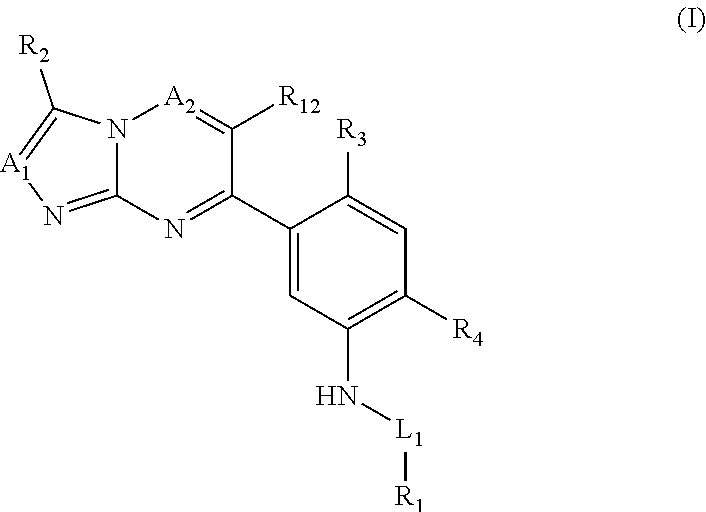Compounds
a technology of compound and compound, applied in the field of compound, can solve the problems of contaminated food outbreaks, drug resistance, drug resistance, and current treatments, and achieve the effects of reducing the risk of infection, and reducing the safety of us
- Summary
- Abstract
- Description
- Claims
- Application Information
AI Technical Summary
Benefits of technology
Problems solved by technology
Method used
Image
Examples
example 1
orpholinoimidazo[1,2-a]pyrimidin-7-yl)phenyl)pyrrolidine-1-carboxamide
[0663]
Triphosgene (ALDRICH, 0.163 g, 0.55 mmol) was added to a stirred suspension of 3-(3-morpholinoimidazo[1,2-a]pyrimidin-7-yl)aniline (Intermediate 13, 0.04 g) in 1,2-dichloroethane (3 mL) at room temperature. The mixture was stirred for 5 minutes. Triethylamine (ALDRICH, 0.03 mL) was added at 0° C. and the mixture was stirred at rt for 30 minutes. Pyrrolidine (ALDRICH, 0.124 mL) was added and the mixture was stirred for 1 hour. The mixture was diluted with DCM, water was added and stirring was continued for 5 min. The phases were separated and the organic phase was dried and evaporated. Crude product was purified by KP-NH column eluting with AcOEt 100%, affording the desired compound as a yellow solid (0.030 g).
[0664]1H NMR (400 MHz, CDCl3): δ 8.47 (1H, m), 8.22 (1H, s, b), 7.81 (2H, m), 7.48 (3H, m), 7.19 (1H, m), 3.95 (4H, m), 3.59 (4H, m), 3.13 (4H, m), 2.03 (4H, m).
[0665]m / z=393 (M+H)
example 2
henylimidazo[1,2-a]pyrimidin-7-yl)phenyl)pyrrolidine-1-carboxamide
[0666]
Triphosgene (ALDRICH, 0.025 g, 0.086 mmol) was added to a stirred solution of 3-(3-phenylimidazo[1,2-a]pyrimidin-7-yl)aniline (Intermediate 8, 0.07 g, 0.24 mmol) in 1,2-dichloroethane (1 ml) at room temperature. The mixture was stirred for 5 minutes during which time a precipitate formed. The mixture was cooled down to 0° C. and triethylamine (ALDRICH, 0.066 mL) was added; the mixture was stirred at rt for 30 minutes. Further triethylamine (0.006 mL) and pyrrolidine (ALDRICH, 0.020 mL) were added and the mixture was stirred for 1 hour. UPLC check showed the reaction was complete. Water was added and the mixture was extracted with DCM. The organic phase was evaporated under reduced pressure. Chromatography of the residue (SNAP Cartridge, KP-NH, 12 g, DCM / MeOH, 100:0-95:5) afforded the title compound as a yellow solid (0.035 g, 38% yield).
[0667]1H NMR (400 MHz, DMSO-d6): δ 9.08 (1H, d), 8.43 (2H, d), 8.00 (1H, s),...
example 3
ro-3-(3-phenylimidazo[1,2-a]pyrimidin-7-yl)phenyl)pyrrolidine-1-carboxamide
[0669]
Triphosgene (ALDRICH, 0.029 g, 0.10 mmol) was added to a stirred solution of 4-fluoro-3-(3-phenylimidazo[1,2-a]pyrimidin-7-yl)aniline (Intermediate 9, 0.086 g, 0.28 mmol) in 1,2-dichloroethane (6 ml) at room temperature. The mixture was stirred for 5 minutes during which time a precipitate formed. The mixture was cooled down to 0° C. and triethylamine (ALDRICH, 0.078 mL) was added; the mixture was stirred at rt for 30 minute. Further triethylamine (0.008 mL) and pyrrolidine (ALDRICH, 0.023 mL) were added and the mixture was stirred for 1 hour. UPLC check showed the reaction was complete. Water was added and the mixture was extracted with DCM. The organic phase was evaporated under reduced pressure. Chromatography of the residue (SNAP Cartridge, KP-NH, 12 g, DCM) afforded the title compound as a yellow solid (0.050 g). NMR showed the presence of DCM. The compound was dissolved in MeOH and the solution wa...
PUM
 Login to View More
Login to View More Abstract
Description
Claims
Application Information
 Login to View More
Login to View More - R&D
- Intellectual Property
- Life Sciences
- Materials
- Tech Scout
- Unparalleled Data Quality
- Higher Quality Content
- 60% Fewer Hallucinations
Browse by: Latest US Patents, China's latest patents, Technical Efficacy Thesaurus, Application Domain, Technology Topic, Popular Technical Reports.
© 2025 PatSnap. All rights reserved.Legal|Privacy policy|Modern Slavery Act Transparency Statement|Sitemap|About US| Contact US: help@patsnap.com



